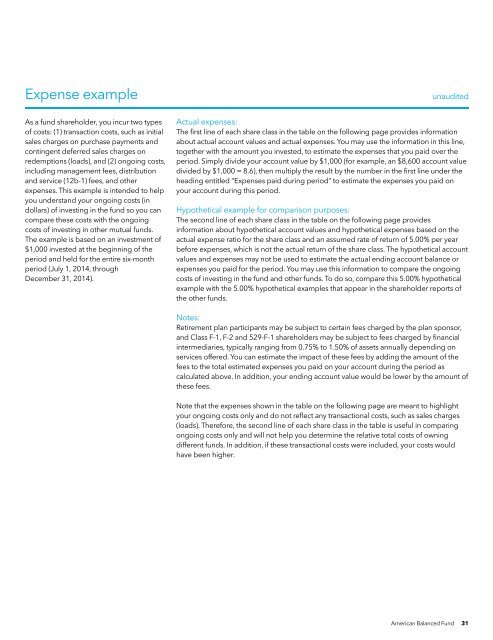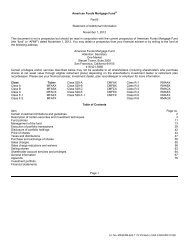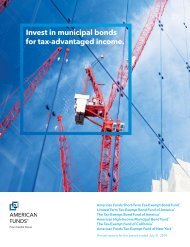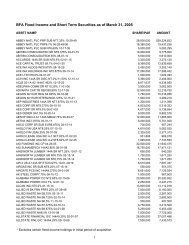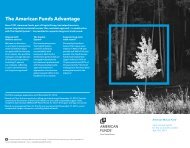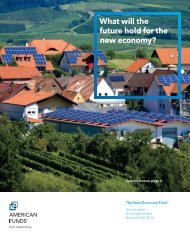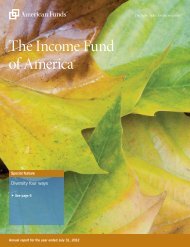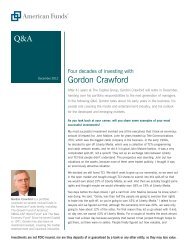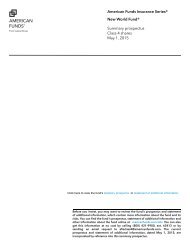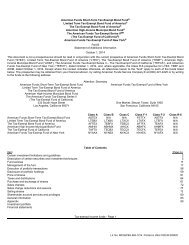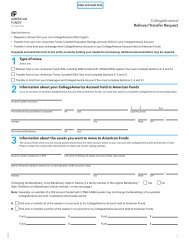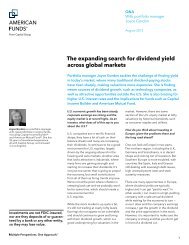Annual Report - American Balanced Fund - American Funds
Annual Report - American Balanced Fund - American Funds
Annual Report - American Balanced Fund - American Funds
You also want an ePaper? Increase the reach of your titles
YUMPU automatically turns print PDFs into web optimized ePapers that Google loves.
Expense exampleunauditedAs a fund shareholder, you incur two typesof costs: (1) transaction costs, such as initialsales charges on purchase payments andcontingent deferred sales charges onredemptions (loads), and (2) ongoing costs,including management fees, distributionand service (12b-1) fees, and otherexpenses. This example is intended to helpyou understand your ongoing costs (indollars) of investing in the fund so you cancompare these costs with the ongoingcosts of investing in other mutual funds.The example is based on an investment of$1,000 invested at the beginning of theperiod and held for the entire six-monthperiod (July 1, 2014, throughDecember 31, 2014).Actual expenses:The first line of each share class in the table on the following page provides informationabout actual account values and actual expenses. You may use the information in this line,together with the amount you invested, to estimate the expenses that you paid over theperiod. Simply divide your account value by $1,000 (for example, an $8,600 account valuedivided by $1,000 = 8.6), then multiply the result by the number in the first line under theheading entitled “Expenses paid during period” to estimate the expenses you paid onyour account during this period.Hypothetical example for comparison purposes:The second line of each share class in the table on the following page providesinformation about hypothetical account values and hypothetical expenses based on theactual expense ratio for the share class and an assumed rate of return of 5.00% per yearbefore expenses, which is not the actual return of the share class. The hypothetical accountvalues and expenses may not be used to estimate the actual ending account balance orexpenses you paid for the period. You may use this information to compare the ongoingcosts of investing in the fund and other funds. To do so, compare this 5.00% hypotheticalexample with the 5.00% hypothetical examples that appear in the shareholder reports ofthe other funds.Notes:Retirement plan participants may be subject to certain fees charged by the plan sponsor,and Class F-1, F-2 and 529-F-1 shareholders may be subject to fees charged by financialintermediaries, typically ranging from 0.75% to 1.50% of assets annually depending onservices offered. You can estimate the impact of these fees by adding the amount of thefees to the total estimated expenses you paid on your account during the period ascalculated above. In addition, your ending account value would be lower by the amount ofthese fees.Note that the expenses shown in the table on the following page are meant to highlightyour ongoing costs only and do not reflect any transactional costs, such as sales charges(loads). Therefore, the second line of each share class in the table is useful in comparingongoing costs only and will not help you determine the relative total costs of owningdifferent funds. In addition, if these transactional costs were included, your costs wouldhave been higher.<strong>American</strong> <strong>Balanced</strong> <strong>Fund</strong> 31 3


